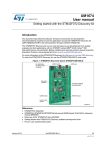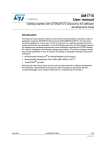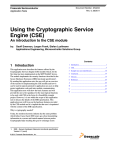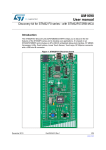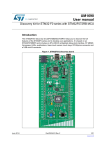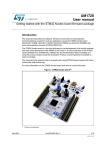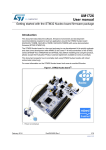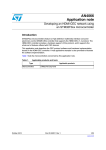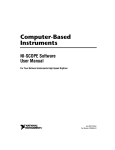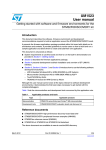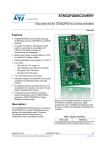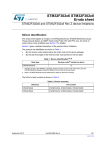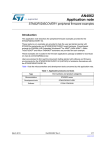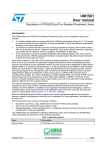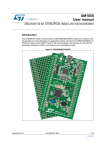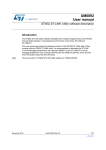Download STM32F0xx Snippets firmware package
Transcript
STM32SnippetsF0
STM32F0xx Snippets firmware package
Data brief
Features
Complete free C source code firmware
examples for STM32F0xx microcontrollers
Basic examples using register direct-accesses
as defined in CMSIS Cortex-M0 Device
Peripheral Access Layer Header File
(sm32f0xx.h)
Self-documented code
Compliant with MISRA
Compliant with EWARM and MDK-ARM
Description
STM32F0xx snippets provide a free source-code
for the STM32F0xx microcontroller family. The
package includes a set of examples to help the
designers when creating their own fully optimized
C-code application on standard microcontrollers.
Table 1. Device summary table
Type
Product family
Part number
Microcontroller
STM32F0 series
Development tools
STM32F0 Discovery
32F072BDISCOVERY
Software
STM32 Embedded Software
STM32SnippetsF0
February 2014
DocID025802 Rev 1
For further information contact your local STMicroelectronics sales office.
-
1/14
www.st.com
Contents
STM32SnippetsF0
Contents
1
General overview . . . . . . . . . . . . . . . . . . . . . . . . . . . . . . . . . . . . . . . . . . . . 3
1.1
1.1.1
Acronyms . . . . . . . . . . . . . . . . . . . . . . . . . . . . . . . . . . . . . . . . . . . . . . . . . 3
1.1.2
Naming conventions . . . . . . . . . . . . . . . . . . . . . . . . . . . . . . . . . . . . . . . . 4
1.1.3
Coding rules . . . . . . . . . . . . . . . . . . . . . . . . . . . . . . . . . . . . . . . . . . . . . . . 4
1.2
Architecture . . . . . . . . . . . . . . . . . . . . . . . . . . . . . . . . . . . . . . . . . . . . . . . . 4
1.3
Package description . . . . . . . . . . . . . . . . . . . . . . . . . . . . . . . . . . . . . . . . . . 4
1.4
2
Coding rules and conventions . . . . . . . . . . . . . . . . . . . . . . . . . . . . . . . . . . 3
1.3.1
Library folder structure . . . . . . . . . . . . . . . . . . . . . . . . . . . . . . . . . . . . . . . 5
1.3.2
Project folder . . . . . . . . . . . . . . . . . . . . . . . . . . . . . . . . . . . . . . . . . . . . . . 6
Supported devices and development tools . . . . . . . . . . . . . . . . . . . . . . . . 6
1.4.1
Supported devices . . . . . . . . . . . . . . . . . . . . . . . . . . . . . . . . . . . . . . . . . . 6
1.4.2
Supported development tools and compilers . . . . . . . . . . . . . . . . . . . . . . 7
Using and configuring an example . . . . . . . . . . . . . . . . . . . . . . . . . . . . . 8
2.1
Using an example . . . . . . . . . . . . . . . . . . . . . . . . . . . . . . . . . . . . . . . . . . . . 8
2.2
Configuring an example . . . . . . . . . . . . . . . . . . . . . . . . . . . . . . . . . . . . . . . 9
2.3
Programming model . . . . . . . . . . . . . . . . . . . . . . . . . . . . . . . . . . . . . . . . . 10
2.4
Running your examples . . . . . . . . . . . . . . . . . . . . . . . . . . . . . . . . . . . . . . 10
2.4.1
Prerequisites . . . . . . . . . . . . . . . . . . . . . . . . . . . . . . . . . . . . . . . . . . . . . 10
2.4.2
Running an example . . . . . . . . . . . . . . . . . . . . . . . . . . . . . . . . . . . . . . . 11
2.4.3
Looking for specific feature . . . . . . . . . . . . . . . . . . . . . . . . . . . . . . . . . . 11
3
References . . . . . . . . . . . . . . . . . . . . . . . . . . . . . . . . . . . . . . . . . . . . . . . . 12
4
Revision history . . . . . . . . . . . . . . . . . . . . . . . . . . . . . . . . . . . . . . . . . . . 13
2/14
DocID025802 Rev 1
STM32SnippetsF0
General overview
1
General overview
1.1
Coding rules and conventions
This section describes the conventions used in the present document and in the library.
1.1.1
Acronyms
Table 2 presents the acronyms used in this document.
Table 2. Glossary
Acronym
Definition
ADC
Analog-to-Digital Converter
CAN
Controller Area Network
COMP
Analog COMparators
CRC
CRC calculation unit
DAC
Digital to Analog Converter
DBGMCU
DeBuG MCU
DMA
DMA controller
EXTI
External interrupt/event controller
FLASH
FLASH memory
GPIO
General Purpose I/O
I2C
Inter-Integrated Circuit
I2S
Inter-Integrated Sound
IWDG
Independent WatchDoG
NVIC
Nested Vectored Interrupt Controller
PWR
PoWeR control
RCC
Reset and Clock Controller
RTC
Real-Time Clock
SPI
Serial Peripheral Interface
SysTick
System TICK timer
TIM
Advanced-control, general-purpose or basic timer
USART
Universal Synchronous Asynchronous Receiver Transmitter
WWDG
Window WatchDoG
DocID025802 Rev 1
3/14
14
General overview
1.1.2
STM32SnippetsF0
Naming conventions
The following naming conventions are used in the library:
PPP refers to any peripheral acronym, for example ADC. See Section 1.1.1: Acronyms
for more information.
Constants used in one file are defined within this file. A constant used in more than one
file is defined in a header file. All constants are written in upper case, except for
peripheral driver function parameters.
Registers are considered as constants. In most cases, their name is in upper case and
uses the same acronyms as in the STM32F0xx reference manual.
1.1.3
Coding rules
This section describes the coding rules used in the snippets.
General
All codes should comply with ANSI C standard and should compile without warning
under at least its main compiler. Any warnings that cannot be eliminated should be
commented in the code.
The snippets use ANSI standard data types defined in the ANSI C header file
<stdint.h>.
The application code shall not have any blocking code. The designers define their own
policy to avoid endless loops. Each time a polling is performed in a snippet, a comment
reminds the designers to add a time-out management as shown hereafter:
while ((ADC1->CR & ADC_CR_ADEN) != 0)
{
/* For robust implementation, add here time-out management */
}
1.2
Architecture
To fully optimize the application code, the snippets access directly the CMSIS layers (Core
Peripheral Access Layer + STM32F0xx Device Peripheral Access Layer).
1.3
Package description
The snippets are supplied in one single zip file. The zip file extraction results in the creation
of the folder STM32F0xx_Snippets_Package_VX.Y.Z, where VX.Y.Z refers to the snippets
version, for example V1.0.0. Figure 1 shows the Snippets package structure.
4/14
DocID025802 Rev 1
STM32SnippetsF0
General overview
Figure 1. Snippets package structure
The snippets package consists of three main folders, described in Section 1.3.1: Library
folder structure.
1.3.1
Library folder structure
This folder contains all the CMSIS files.
The library folder structure is shown in Figure 2.
Figure 2. Library folder structure
DocID025802 Rev 1
5/14
14
General overview
STM32SnippetsF0
CMSIS sub folder
The CMSIS sub folder contains the STM32F0xx and Cortex-M0 CMSIS files:
Cortex-M CMSIS files include the name definitions, address definitions and helper
functions to access Cortex-M0 core registers and peripherals. They also includes the
setup to use to define a device independent interface for RTOS kernels that includes
debug channel definitions.
STM32F0xx CMSIS files consist of:
–
stm32f0xx.h: this file contains the definitions of all peripheral registers, bits, and
memory mapping for STM32F0xx devices. It is the unique include file used in the
application programmer C source code, usually in the main.c.
–
system_stm32f0xx.c/.h: this file contains the system clock configuration for
STM32F0xx devices. It exports SystemInit() function which sets up the system
clock source, PLL multiplier and divider factors, AHB/APB prescalers and Flash
settings. This function is called at startup just after reset and before connecting to
the main program. The call is made inside the startup_stm32f0xx.s file.
–
startup_stm32f0xx.s: this file contains the Cortex-M0 startup code and interrupt
vectors for all STM32F0xx device interrupt handlers.
1.3.2
Project folder
This folder contains for each peripheral the minimum set of files needed to run a typical
example on a peripheral.
Aside the IDE folders, two source files are provided:
main.c: this file contains the snippets code itself.
system_stm32f0xx.c: this file is the same for all examples, the main clock parameters
are PLL x12 and HSI divided by 2, so the system clock is 48 MHz.
1.4
Supported devices and development tools
1.4.1
Supported devices
The snippets support the whole STM32F0 series of microcontrollers and peripherals.
Some examples in the Snippets firmware may use a feature that is not present in all
STM32F0xx devices. The target board of the snippets is the STM32F072 Discovery board.
The STM32F072 device supports the full set of peripherals. When using a derivative of
STM32F0, refer to the device datasheet to check the targeted feature availability.
6/14
DocID025802 Rev 1
STM32SnippetsF0
1.4.2
General overview
Supported development tools and compilers
Lead suppliers support the STM32F0xx devices with a full range of development solutions.
They deliver start-to-finish control of application development from a single integrated
development environment.
A project is available for some development tools:
IAR Embedded Workbench for ARM (EWARM) development tool
–
Compiler: IAR C/C++ compiler
RealView Microcontroller Development Kit (MDK-ARM) development tool
–
Compiler: ARM C/C++ compiler
DocID025802 Rev 1
7/14
14
Using and configuring an example
2
STM32SnippetsF0
Using and configuring an example
The following sections provide the steps required to configure, customize, and run your first
example. They also provide the steps to follow to develop your application from the snippet
examples.
2.1
Using an example
Each example folder contains the workspace/project files corresponding to a supported
toolchain. Once you have installed one of these toolchains, double-click on the workspace
file in the corresponding folder to launch the IDE:
for IAR: \Projects\PPP\nn_ExampleName\EWARM\project.eww
for MDK-ARM: \Projects\PPP\nn_ExampleName\MDK-ARM\project.uvproj
Only the main.c differs from one example to another. The code is self-documented with:
a brief description,
the used MCU resources,
the files needed to build the example,
the expected behavior,
a way to test if the code is executed correctly.
**************************************************************************
* @file
03_MCO_GPIO_Configuration/main.c
* @author
MCD Application Team
* @version V0.0.1
* @date
20-December-2013
* @brief
This code example shows how to output the system clock on MCO
*
==========================================================================
#####
MCU Resources
#####
==========================================================================
- RCC
- GPIO PA8,PC8,9
==========================================================================
##### How to use this example #####
==========================================================================
- this file must be inserted in a project containing
the following
files :
o system_stm32f0xx.c, startup_stm32f0xx.s
o stm32f0xx.h to get the register definitions
o CMSIS files
==========================================================================
##### How to test this example #####
==========================================================================
8/14
DocID025802 Rev 1
STM32SnippetsF0
Using and configuring an example
- This examples configure the PA8 to output the system clock.
- The signal on PA8 @4MHz can be monitored with an oscilloscope
2.2
Configuring an example
1.
2.
3.
Note:
Create a project and setup all your toolchain startup files.
Select the startup file corresponding to the used device:
–
EWARM: startup_stm32f0xx.s, under
Libraries\CMSIS\Device\ST\STM32F0xx\Source\Templates\iar
–
MDK-ARM: startup_stm32f0xx.s, under
Libraries\CMSIS\Device\ST\STM32F0xx\Source\Templates\arm
The device entry point is stm32f0xx.h (under
Libraries\CMSIS\Device\ST\STM32F0xx\Include), the user must include
stm32f0xx.h in the application main.
You can select the device in the project settings of the IDE. All the examples have the
STM32F072 device selected.
4. Add the system_stm32f0xx.c (under
Libraries\CMSIS\Device\ST\STM32F0xx\Source\Templates) file in your
application. This file provides the functions to setup the STM32 system, that is to
configure the PLL, the system clock and initialize the Embedded Flash Interface. This
file provides multiple choice for the system clock frequency.
The system_stm32f0xx file configures the system clock as shown in Table 3:
Table 3. System clock configuration
Parameter
Value
System clock source
PLL(HSI/2)
SYSCLK
48000000 Hz
HCLK
48000000 Hz
AHB prescaler
1
APB prescaler
1
HSE frequency
8000000 Hz
PLL source
HSI/2
PLL MUL
12
VDD
3.3 V
Flash latency
1 WS
DocID025802 Rev 1
9/14
14
Using and configuring an example
2.3
STM32SnippetsF0
Programming model
Direct register access
This model is based on direct register access using the CMSIS layer. This layer provides the
definition of all STM32F0xx peripheral registers and bits, as well as memory mapping as
defined in stm32f0xx.h file.
The advantage of this approach if that the code produced is compact and efficient. The
developer shall refer to the STM32F0 Reference Manual to know in details the peripheral
operation, the registers and bits meaning, and the configuration procedure.
2.4
Running your examples
The snippet package provides a rich set of examples covering the main features of each
peripheral.
All the examples are independent from the development tools. The examples run on
STMicroelectronics STM32F072 Discovery board. They can be easily tailored to any other
supported device and development board. Source files and projects are provided for each
example for a limited set of development tools.
2.4.1
Prerequisites
1.
2.
3.
4.
10/14
Latest release of documents and snippet code. You can download the latest version of
STM32F0xx related documents and snippets from STMicroelectronics website:
www.st.com/stm32
Hardware: the snippets have been designed to run on the STM32F072 Discovery
board from STMicroelectronics.
To use your own hardware, simply adapt the example hardware configuration to your
platform, that is the GPIO configuration and alternate function.
Development tools:
Use your preferred development tool: MDK-ARM (Keil) and EWARM (IAR). Check that
the version you are using supports STM32F0xx devices.
DocID025802 Rev 1
STM32SnippetsF0
2.4.2
Using and configuring an example
Running an example
This section describes how to load and execute an example provided within the Snippets
package.
Proceed as described below to load and execute an example:
1. Download and unzip the STM32F0xx_Snippets_Package_VX.Y.Z.zip in the folder of
your choice.
2. Check information in «How to use this example» in main.c to know if some solder
bridges must be shunted.
3. Power-up the STM32F072 Discovery board
4. The STM32F072 Discovery features a built-in ST-Link/V2 debugger and programmer
which prevent from having to use external hardware debuggers to load and debug your
program.
5. Select ST-Link/V2 as your debugger in the Development Tool configuration menu and
connect the «USB ST-LINK» mini USB connector to your host PC through an USB
cable.
6. Run the snippet example of your choice:
a) EWARM
–
Open the EWARM\Project.eww workspace
–
Rebuild all files: Project->Rebuild all
–
Load the project image: Project->Debug
–
Run the program: Debug->Go(F5)
b) MDK-ARM
–
Open the MDK-ARM\Project.uvproj project
–
Rebuild all files: Project->Rebuild all target files
–
Load the project image: Debug->Start/Stop Debug Session
–
Run the program: Debug->Run (F5)
Test the behavior of the application with the expected behavior that is described in the «How
to test this example» section in main.c.
2.4.3
Looking for specific feature
To avoid the duplication of the examples, some features or configurations are only present
in some examples.
All the configurations related to GPIO or RCC can be found in all the examples as a signal
must always be output and the clock must always be configured.
The examples are sorted by peripherals. For example all the ADC examples are in the
..\projects\ADC folder.
The best way to find a specific feature is to perform a «Find in Files» in your favorite IDE.
Alternatively, use the free Notepad++ editor.
In IAR, perform Edit->Find and Replace->Find in Files
In MDK-ARM, perform Edit->Find in Files
Notepad++, perform Search->Find in Files
DocID025802 Rev 1
11/14
14
References
3
STM32SnippetsF0
References
The following documents have been used as reference to develop the Snippets code.
12/14
1.
AN4055
Clock configuration tool for STM32F0xx microcontroller, application note
2.
AN4235
I2C timing configuration tool for STM32F3xxxx and STM32F0xxxx
microcontrollers, application note
3.
DS9826
ARM-based 32-bit MCU, up to 128 KB Flash, crystal-less USB FS 2.0,
CAN, 12 timers, ADC, DAC & comm. interfaces, 2.0 - 3.6 V, Datasheet
4.
RM0091
STM32F0x1/STM32F0x2/STM32F0x8 advanced ARM-based 32-bit MCUs,
reference manual
5.
UM1690
Discovery kit for STM32 F0 series - with STM32F072RB MCU, user manual
6.
UM1715
Getting started with STM32F072B Discovery software development tools,
user manual
DocID025802 Rev 1
STM32SnippetsF0
4
Revision history
Revision history
Table 4. Document revision history
Date
Revision
24-Feb-2014
1
Changes
Initial release.
DocID025802 Rev 1
13/14
14
STM32SnippetsF0
Please Read Carefully:
Information in this document is provided solely in connection with ST products. STMicroelectronics NV and its subsidiaries (“ST”) reserve the
right to make changes, corrections, modifications or improvements, to this document, and the products and services described herein at any
time, without notice.
All ST products are sold pursuant to ST’s terms and conditions of sale.
Purchasers are solely responsible for the choice, selection and use of the ST products and services described herein, and ST assumes no
liability whatsoever relating to the choice, selection or use of the ST products and services described herein.
No license, express or implied, by estoppel or otherwise, to any intellectual property rights is granted under this document. If any part of this
document refers to any third party products or services it shall not be deemed a license grant by ST for the use of such third party products
or services, or any intellectual property contained therein or considered as a warranty covering the use in any manner whatsoever of such
third party products or services or any intellectual property contained therein.
UNLESS OTHERWISE SET FORTH IN ST’S TERMS AND CONDITIONS OF SALE ST DISCLAIMS ANY EXPRESS OR IMPLIED
WARRANTY WITH RESPECT TO THE USE AND/OR SALE OF ST PRODUCTS INCLUDING WITHOUT LIMITATION IMPLIED
WARRANTIES OF MERCHANTABILITY, FITNESS FOR A PARTICULAR PURPOSE (AND THEIR EQUIVALENTS UNDER THE LAWS
OF ANY JURISDICTION), OR INFRINGEMENT OF ANY PATENT, COPYRIGHT OR OTHER INTELLECTUAL PROPERTY RIGHT.
ST PRODUCTS ARE NOT DESIGNED OR AUTHORIZED FOR USE IN: (A) SAFETY CRITICAL APPLICATIONS SUCH AS LIFE
SUPPORTING, ACTIVE IMPLANTED DEVICES OR SYSTEMS WITH PRODUCT FUNCTIONAL SAFETY REQUIREMENTS; (B)
AERONAUTIC APPLICATIONS; (C) AUTOMOTIVE APPLICATIONS OR ENVIRONMENTS, AND/OR (D) AEROSPACE APPLICATIONS
OR ENVIRONMENTS. WHERE ST PRODUCTS ARE NOT DESIGNED FOR SUCH USE, THE PURCHASER SHALL USE PRODUCTS AT
PURCHASER’S SOLE RISK, EVEN IF ST HAS BEEN INFORMED IN WRITING OF SUCH USAGE, UNLESS A PRODUCT IS
EXPRESSLY DESIGNATED BY ST AS BEING INTENDED FOR “AUTOMOTIVE, AUTOMOTIVE SAFETY OR MEDICAL” INDUSTRY
DOMAINS ACCORDING TO ST PRODUCT DESIGN SPECIFICATIONS. PRODUCTS FORMALLY ESCC, QML OR JAN QUALIFIED ARE
DEEMED SUITABLE FOR USE IN AEROSPACE BY THE CORRESPONDING GOVERNMENTAL AGENCY.
Resale of ST products with provisions different from the statements and/or technical features set forth in this document shall immediately void
any warranty granted by ST for the ST product or service described herein and shall not create or extend in any manner whatsoever, any
liability of ST.
ST and the ST logo are trademarks or registered trademarks of ST in various countries.
Information in this document supersedes and replaces all information previously supplied.
The ST logo is a registered trademark of STMicroelectronics. All other names are the property of their respective owners.
© 2014 STMicroelectronics - All rights reserved
STMicroelectronics group of companies
Australia - Belgium - Brazil - Canada - China - Czech Republic - Finland - France - Germany - Hong Kong - India - Israel - Italy - Japan Malaysia - Malta - Morocco - Philippines - Singapore - Spain - Sweden - Switzerland - United Kingdom - United States of America
www.st.com
14/14
DocID025802 Rev 1














